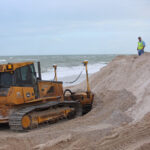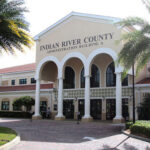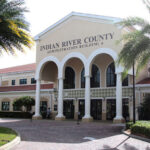INDIAN RIVER COUNTY — The County Commissioners took a leap of faith by voting 5-0 to allow ranch land owned by prominent farming families to be developed into an enormous science or green industrial park.The nearly 700 acres of land is one piece of a plan to eventually convert the use of 5,500 acres into a new business plan for the 21st century. The subject property is held by a handful of owners, ranching and citrus farmers, who jointly applied for the rezoning. One of those owners, rancher Dan Corrigan and his family, who have been raising cattle on the expanse west of what is now the CVS complex for more than 60 years, are planning to phase out their ranching business and instead return 93 percent of the land to wetland. Once the wetland bank was established, developers would then purchase credits in that wetland to offset impacts of residential and commercial construction on the wetlands that currently exist on the property they are considering. Credits from the wetland mitigation bank, as this type of business is called, could be purchased anywhere within the Upper Basin of the St. John’s River Water Management District. Corrigan said this area spans three counties, beginning near the Melbourne International Airport in the north, running west of I-95 and down into St. Lucie County. The idea is to compensate for the loss of wetland in areas east of I-95 to the coast within the same geographic region. The Upper Basin of the St. John’s River includes areas adjacent to Fellsmere, the Stick Marsh and the Blue Cypress Management area. The addition of more than 5,000 contiguous acres of wetland to connect conservation lands already set aside by state and county agencies could greatly enhance the ecological importance of the existing marshland. Commissioner Wesley Davis, known to be a strong advocate for the agriculture community, pointed out that the county recently paid $25 million to place 1,700 acres near the Corrigan property into conservation. Gaining more than three times this amount of conservation land without the hefty pricetag was seen as very attractive to the county by commissioners.The ability of wetlands to purify and add water to the area’s important underground aquifers are also a crucial aspect of planning for development and adequate water management to avoid water shortages going forward as the population grows.The part where the faith comes in is that there are no partnership agreements and no site plans drawn up for the industrial park yet, just a loose coalition of the families who own the property. There also is no firm commitment from the Corrigans to convert some or all of their ranchland back to its natural state. If the pending permits fall through, the county could be stuck with the change in land use for the industrial park without the benefit to wildlife and the environment of the massive stretch of wetland.The county has no official say in whether or not the Corrigan ranch is approved as a mitigation bank.”You’re not going to hear much about the mitigation bank except from me,” Marine told commissioners. “You don’t have jurisdiction over that.”Chairman Peter O’Bryan, who serves as liaison to the county’s Economic Development Council, voiced his concern that the fuzzy concept of an industrial park without concrete plans would not be marketable.”There are five property owners here of this proposed industrial park. Five or 10 or 15 years down the road, what kind of assurance can you give us that this will be developed as a research and industrial park?” O’Bryan asked. Marine responded that the development of the commercial area is the lynch pin of the plan, the part which will make the ceasing of the cattle operation financially feasible in the long run for the Corrigan family. Without that part, the selling of mitigation credits alone would not provide enough income to justify returning 93 percent of the family’s land back to its natural state.”The only assurance I can give you is that it will only be developed according to the land development regulations,” Marine said.O’Bryan, still not completely satisfied, impressed upon the applicants the importance of having a marketable plan very soon.”I want something that we can go out, and so the chamber folks can start selling,” O’Bryan said. “I don’t want to create this and nothing ever gets done with it.”O’Bryan was also hesitant about the fact that the wetland mitigation bank would be flooded in phases and not all at once.”You’re selling it as 5,000 acres, I think we should be getting the whole 5,000,” he said.Marine said the family would need to keep “running cattle” on part of the land until the credits on the other part turned into wetland were sold.”Financially it’s a huge calculated risk,” said Commissioner Bob Solari of the Corrigan’s plan. “It puts their whole operation at risk.”Marine said his clients are banking on Indian River County’s current development slump to reverse itself in short order.”The gamble the family is taking is that development — both public and private — will come back,” he said. “If the past couple of years are any indication they’re going to have to keep running cattle for a while.”Commissioners, eager to do something which could potentially be good for both the economy and the environment, unanimously took the Corrigans and their attorney Chris Marine, who also hails from a well-respected long-time Vero family, on their word that the project would not only get done, but that it would be done the right way. Marine is a partner at the beachside law firm of Gould Cooksey Fennell. Attorney Bruce Barkett, who specializes in development and environmental issues related to real estate, serves on the Board of the Florida Inland Navigation District and appears before the county commission regularly representing developers and residents, is working with one of the families who own property contained in the re-zoning area.The conversion of the ranch land into wetlands would place more than 5,000 acres into a permanent conservation easement, effectively taking it off the county’s tax rolls. When asked after the meeting if this was a consideration of which way he would vote, Commissioner Gary Wheeler said he felt the financial benefits would outweigh taking agriculturally exempt land — which is taxed at a very low rate — off the tax rolls.”The land re-zoned to commercial-industrial from ag-exempt would then be taxed at a higher rate, so I think the result would be a net positive,” Wheeler said.The potential down side to the development of a research or green industrial park on the land would be the need for massive expansion to roadways leading to and from the park. County staff estimated that the traffic impact fees alone, if site plans were approved for development of the entire 700 acres, would be about $22 million. Not only State Road 60 would need to be widened, but also I-95 and at least two local roads, to accommodate the additional traffic.The approved changes amount to an expansion of the county’s Urban Service Area westward. Because this would necessitate changes in the county’s Comprehensive Plan, the changes will now be submitted to the Florida Department of Community Affairs for review. Public hearings will be held to gain input from the community about the changes to land development regulations an comp plan.
Commissioners agree to re-zoning of ranch land for massive research park
previous post






